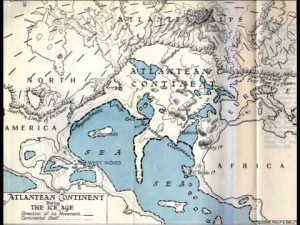Atlantic landbridge
Cushing, Volney Byron
Volney Byron Cushing (1856-1916) was an American lecturer who had two interests, decrying the  evils of alcohol and promoting the reality of Atlantis. With regard to temperance, Cushing was an active member of the Prohibition Party which has existed since 1869. In connection with the latter, he frequently delivered a lecture entitled The Lost Atlantis, the text of which seems to be lost. He apparently echoed many of Donnelly’s ideas, as well as the possibility of an Atlantic landbridge.
evils of alcohol and promoting the reality of Atlantis. With regard to temperance, Cushing was an active member of the Prohibition Party which has existed since 1869. In connection with the latter, he frequently delivered a lecture entitled The Lost Atlantis, the text of which seems to be lost. He apparently echoed many of Donnelly’s ideas, as well as the possibility of an Atlantic landbridge.
Davis, Asahel
Asahel Davis (1791-?) a former chaplain of the Senate of New York, delivered a lecture in 1839, Antiquities of America [1276]+, in which he offered a strong defence for a Scandinavian, or as he calls them ‘Northmen’, discovery of America five hundred years before Columbus.
When speaking of Atlantic landbridges he stated that “I’m inclined to believe that the land that united the now two continents, was the Atlantis, spoken of by Plato, Homer and Hesiod – Plato saw an account of this land which disappeared, in the hieroglyphics of Egypt.” [p.11].
At least twelve editions of his paper have been published.(a)
[1276]+ https://babel.hathitrust.org/cgi/pt?id=loc.ark:/13960/t70v8v035;view=1up;seq=9 (4thedition) *
https://babel.hathitrust.org/cgi/pt?id=loc.ark:/13960/t3cz3k98r;view=1up;seq=5 (12th edition 1844) *
Newman, John B.
John B. Newman, was a 19th century American physician who produced a short volume[488] purporting to demonstrate connections between the Phoenicians, Atlanteans and Native Americans. He was one of the earliest proponents of a large island stretching across the Atlantic from northwest Africa towards America, providing a stepping-stone or landbridge between the Old and New Worlds for animals and man.
It is worth pointing out that it was written in 1849, over thirty years before Ignatius Donnelly published his influential work.
Forrest, Herbert Edward
Herbert Edward Forrest was a Welsh naturalist, who endeavoured to convince his readers[298] that a landbridge had existed across the North Atlantic  within the memory of humans and that it had been the location of Atlantis. His book includes a speculative map showing Atlantis at the time of the last Ice Age.
within the memory of humans and that it had been the location of Atlantis. His book includes a speculative map showing Atlantis at the time of the last Ice Age.
Others, in the early part of the 20th century, supported this suggestion; such as Dr. R. F. Scharff although the idea was strongly opposed by the likes of William Diller Matthew(1871-1930), professor of palaeontology at the University of California(a). Eventually, this ill-founded idea of an Atlantic landbridge during the Holocene Era sank from view and has no serious support today.
>However, an interesting review of Forrest’s book was published in 2015 by Ferdinand Speidel on the Atlantisforschung website in German. I have added a Google Translation below(b).<
(a) https://www.ncbi.nlm.nih.gov/pmc/articles/PMC1084374/?page=1
